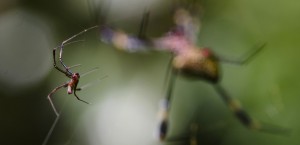Males will mate with anything. Well, that is the general view, one that exists because of a simple biological underpinning: females are reproductively limited by costly gestation, while males are only limited by their number of partners.
As a result, if males want to increase their number of offspring, they should mate with anything, right? The problem with this line of thought is that it assumes that all males have equal access to all females – an assumption any high school student could tell you is false.
In a study published in American Naturalist this week, Alex Jordan, Hanna Kokko and I explored the understudied factors that limit male access to females to determine how they affect male mate choice in golden orb-web spiders.
We show that males are choosy because they are forced to be by rivals. But through their choices, they’re behaving rationally: males perfectly balanced the intensity of competition with a female’s quality allowing them to maximise their success.
Preference versus choice
Whether it’s a knight riding a valiant steed or simply someone who is able to clean after themselves and remember your birthday, we all have traits that we value in a prospective partner.
Our preferences aren’t static and the relative importance of specific traits changes in response to internal factors such as the type of relationship we are looking for or our personality.
But there is an obvious disconnect between what we prefer in a partner and what we end up choosing. In studies of mate choice, researchers often ignore one of the strongest factors likely to shift choice away from preference: intrasexual competition.
Visiting a nightclub on a busy night can shed some light on the importance of competition in real time.
Certain individuals attract more attention, and therefore, competition. As the evening progresses, the pool of potential mates shrinks faster than a photoshopped waistline due to individuals partnering up. This changes the mating market – those waiting too long will have very little to choose from and will likely leave with a mate that wouldn’t have been their first choice.
To really understand mate choice, especially in males, thus requires examining how competition affects choice. To do so, my colleagues and I decided to work with one of Australia’s iconic animals, the golden orb-web spider.
Ladies good enough to die for
Step into any Australian backyard and you’re likely within arm’s reach of a golden orb-web spider (genus Nephila). Their golden webs decorate parks and backyards, and to the dismay of runners, encroach on paths.
Apart from their golden webs, what’s most noticeable is the large female sitting in the centre surrounded by diminutive suitors. These males need to wait patiently until the female is occupied with prey before they make any sexual advances – otherwise they will be courting death rather than a receptive female.

Michael Kasumovic
A male’s position on this web tells us a lot about his competitive ability and potential success. Males closer to females are better competitors and are able to mate first, allowing them to father more offspring.
What we knew was that males generally prefer larger females as they produce more offspring. What we didn’t understand was why some males chose smaller females when larger ones were available.
To examine what alters a male’s choice, we collected hundreds of males and females and marked them to allow individual identification. We then built a 16m3 enclosure and allowed 12 females to settle naturally.
The next day, we released 12 marked males into the enclosure and followed where each of them settled to determine their initial preference. Under this moderate level of competition, we found that males preferred the largest females. And just like previous results, larger males were settled closer to the female.
The next day, we doubled the intensity of competition by adding 12 new males and then monitored what the initial males did. Like a high school cafeteria after the return of the popular kids, we found that males reorganised themselves.
But it was how this reorganisation occurred which was really interesting.

Michael Kasumovic
The previous males at the lower end of the hierarchy were displaced by larger rivals that also preferred the larger females. These smaller males then left. But rather than simply searching for the next nearest female, males targeted smaller females with fewer suitors.
Although these females were initially less preferred, males could sit higher up on the totem pole. These “loser” males thus ensured they lost no fitness by increasing their mating order with a lower quality female. In this manner, males perfectly balanced a female’s reproductive output with the intensity of competition.
What’s love got to do with it?
We expect females to be choosy simply because the costs of making a bad choice are so high.
Our results show that males are choosy too, but for completely different reasons. Choice is a consequence of being forced away from what they prefer rather than the concern about mating with the wrong mate.
Our results also help to explain another biological conundrum — the existence of competitively inferior males. We show that their genes are propagated in populations because they choose to mate with less preferred females.
This mating strategy can be applied to males of all species. Back to the night club, individuals that recognised they stood a poor chance would benefit from aiming lower. This may allow them to leave with someone a little closer to their preference.
It seems we can all learn something from our eight-legged neighbours.
![]()
Michael Kasumovic receives funding from the Australian Research Council for his research exploring the evolution of mate choice and mating strategies.
This article was originally published on The Conversation.
Read the original article.


